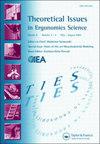Discomfort: an assessment and a model
IF 1.4
Q4 ERGONOMICS
引用次数: 2
Abstract
Abstract Interaction with and dependency on intelligent autonomous systems, may bring about feelings such as discomfort or fear. Users’ willingness to accept new technologies can be hampered by unwanted emotions like discomfort, making the study of the onset of discomfort essential for future technology design and implementation. Interest in discomfort has been growing but agreed-upon definitions or models are still wanted. Here, we present a theoretical model of discomfort predicated upon existing models and definitions. Our model emphasizes internal mental processes that guide the formation of discomfort. Specifically, we specify how environmental stimuli are linked to personal needs and expectations, and how that gap between internal and external factors contributes to discomfort. We conclude with a practical example of how our model can apply to the design of autonomous vehicles.不适:一种评估和模型
摘要与智能自主系统的交互和依赖可能会带来不适或恐惧等感觉。用户接受新技术的意愿可能会受到不必要情绪的阻碍,如不适,这使得对不适发作的研究对未来的技术设计和实施至关重要。人们对不适感的兴趣一直在增长,但仍需要达成一致的定义或模型。在这里,我们提出了一个基于现有模型和定义的不适理论模型。我们的模型强调引导不适形成的内在心理过程。具体来说,我们详细说明了环境刺激与个人需求和期望之间的联系,以及内部和外部因素之间的差距如何导致不适。最后,我们以一个实际例子来说明我们的模型如何应用于自动驾驶汽车的设计。
本文章由计算机程序翻译,如有差异,请以英文原文为准。
求助全文
约1分钟内获得全文
求助全文

 求助内容:
求助内容: 应助结果提醒方式:
应助结果提醒方式:


